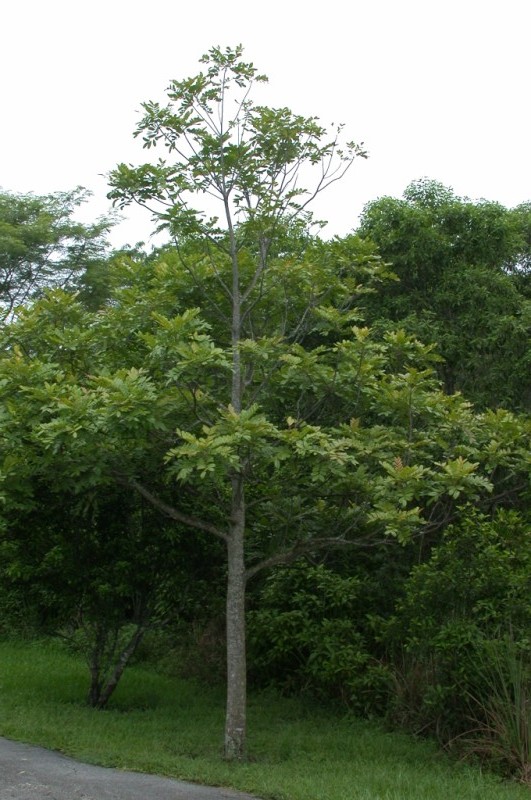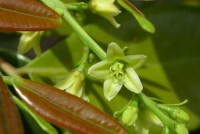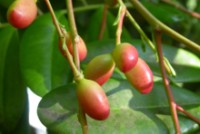PARADISE TREE
 |
 |
Flower |
 |
Simarouba Tree |
Fruits |
Botanical name : Simarouba glauca DC.
Family : Simaroubaceae
Distribution
It is an exotic species introduced from El-Salvador of Central America. It is a versatile multipurpose tree, which can grow well even in the degraded soils. This tree is regarded as highly suitable for growing on both arable and non-arable wastelands.
Environmental requirement
Climate and Temperature
It grows well up to 1000m MSL. The temperature of the species is 17-35°C with an annual rainfall of 500-2200 mm.
Soil
In all types of well-drained soil with pH 5.5-8.0. However, a minimum of 1.0 m deep soil is preferred for its growth. Soils of shallow depth with canker underneath are relatively unfavourable for its growth.
Phenology
The tree starts flowering and fruiting at about three years of age. Flowering is annual beginning in December and continuing up to February. The tree starts bearing when they are 4-6 years old and reach stability in production of another 4-5 years. The droplets (blackish purple in pink genotypes and brownish yellow in green genotypes) are ready for harvest by March/April. Season and duration of reproductive phenoperiods vary according to location and climate. Individual fruits have a development and ripening period of 1-2 months. Fruit is ellipsoid drupe, 2 - 2.5 cm long, with thin hard cuticle and juicy fruit pulp.
Silviculture
Simarouba glauca DC. (Family. Simaroubaceae), commonly known as aceituno, Simarouba or tree of heaven, is a medium sized evergreen tree (height 7-15 m) with tap root system and cylindrical stem. It is an exotic species introduced from El-Salvador of Central America. It is a versatile multipurpose tree, which can grow well even in the degraded soils. This tree is regarded as highly suitable for growing on both arable and non-arable wastelands. It needs no special care and requires minimum protection as it is generally not browsed by cattle, goats and sheep (Syamsundar Joshi etal, 1996).
Climate and Soil
It grows well up to 1000m MSL in all types of well-drained soil with pH 5.5-8.0. However, a minimum of 1.0 m deep soil is preferred for its growth. The temperature of the species is 17-35°C with an annual rainfall of 500-2200 mm. Soils of shallow depth with canker underneath are relatively unfavourable for its growth.
Flowering and Fruiting
The tree starts flowering and fruiting at about three years of age. Flowering is annual beginning in December and continuing up to February. The tree starts bearing when they are 4-6 years old and reach stability in production of another 4-5 years. The droplets (blackish purple in pink genotypes and brownish yellow in green genotypes) are ready for harvest by March/April. Season and duration of reproductive phenoperiods vary according to location and climate. Individual fruits have a development and ripening period of 1-2 months. Fruit is ellipsoid drupe, 2 - 2.5 cm long, with thin hard cuticle and juicy fruit pulp.
Utilization
All the parts of Simaruba are useful in one-way or the other. The seeds are considered economically important as they contain 50-65 per cent edible oil, which can be used in the manufacture of vanaspathi. From 1950 onwards, in El-Salvador and other Central American countries the oil is marketed for edible purposes under the trade name Manteea Vegetal 'Nieve" and the demand for the product has steadily increased. As industrial oil, it is well suited for the manufacture of quality soaps, lubricants, paints, polishes, pharmaceuticals, etc. (Syamsundar Joshi and Shantha Hiremath, 2000). The pressed cake resulting from the milling operation contains a very high percentage of protein (64%) and can be used as a cattle feed after the extraction of toxic elements. The pressed cake is also being utilized as organic fertilizers. The shells (endocarp) can be used in the cardboard industry. Pulp (about 20 kg/tree/year) constituting about 60 per cent of the fresh fruit by weight contains about 11% sugars and It can be used for juice making or in the fermentation industry. Leaf litter is a good feed for earthworms and it makes good manure. The leaf and the bark contain the chemical viz. quassin, a resinous matter which is helpful in curing amoebiasis, diarrhoea and malaria.
Natural Regeneration
This species regenerate naturally through self-sown seeds disseminated through the excretes of birds and monkeys which feed on these fruits. However, the natural regeneration in the stand population of Simaruba has been found to be very poor.
Artificial Regeneration, Seed Maturity and Seed Collection
The physiological maturity of seeds with maximum germination capacity and longevity is attained 11-13 weeks after flowering when the Simaruba fruits attained peak weight, when embryo is fully developed and enclosed in a hard fibrous endocarp and some of the fruits started falling on the ground. A study at Forest College and Research Institute reported that seed reaches physiological maturity at 13 weeks after flowering, when the fruits are turned into purple colour. The optimum periods of collection is when the colour of the fruits turns from greenish yellow to blackish purple. The fruits are best to collect from the tree since fallen fruits often attacked by soil borne fungus. The fungus is carried along with pulpy fruit in deterioration of seeds. The fruits attacked by the fungus few hours after their fall, as they are pulpy and rich in carbohydrates. The easiest way of collection is to spread a tarpaulin under the trees and collect the fruits after they have been manually stripped of the branches or shed by shaking or beating the branches.
Seed Extraction
For maximum seed quality, grade the fruits to separate undeveloped, immature, damaged and decayed fruits and also grade for colour groups viz., fully green, greenish yellow and dark purple. Discard green fruits, which account for poor quality.After collection, the fruits are transported to the place of processing in gunny bags. Plastic bags or plastic containers should not be used for collection and transportation of fruits. The fruit pulp must be removed immediately after collection, either by hand or in a depulper. Depulping is done by macerating the fruits by hand in a bucket. The skin of the fruit floats on the water when water is poured in the bucket. The seeds with some pulp still adhered to it are transferred to bamboo basket. They are then thoroughly washed under running water. Macerate and wash only small lots of seeds, instead of filling the bucket to the brim avoid stagnation of water for long hours.
Seed Drying
Immediately after extraction seeds must be dried in shade for few hours followed by sun drying to reduce the moisture content. The surface moisture of the seeds should be removed immediately after depulping and washing by drying them. If the rooms are humid and closed, then use of fan, air blower. The seeds should always be spread in a single layer and should not be heaped for uniform drying. The initial moisture level of the seed is 12-15 per cent.
Storage and Viability
Seed is orthodox and if stored at low temperature, it will retain high viability for several years. If the seed is stored in paper/cloth bags at room temperature, 9-12 months storage can be expected without loss in viability. Germination of fresh seed is 70-80 per cent. The seed coated with pulp in a thin skinny epicarp needs to be separated, sun dried and stored till crushed for oil extraction. Any delay in separating the seed and drying, will effects the quality of oil content. The seeds are decorticated before extracting the oil.
Pretreatment
Pretreatment is generally not necessary, since it does not have any dormancy. However, soaking in water for 12 hours may enhance the germination of seeds.
Seed Grading
After drying and cleaning, seed lots should be further conditioned to upgrade the seed quality. This step usually comprises of removal of empty, immature, broken or insects damaged seeds. Separation of full and empty seeds due to specific gravity differences can be accomplished by liquid flotation techniques.
Nursery Technology
i)Sowing in Polybags
Under test condition, seeds are germinated in sand at fluctuating 35-40°C and 12 hours light and other dark condition. In the nursery, seeds are sown in a bed or directly in containers. Freshly collected seed could be sown directly in the container. It normally germinate on the soil surface, since, the seed germination is epigeous. For raising container seedlings, fill the polybags (15 x 25 cm size) with the nursery mixture (soil:sand:FYM in the ratio 3:1:1) sow the seed in the bags@ 1 seed/bag. The seed start germinating on the 15th day after sowing and takes 25 days to complete germination. The germination rate of Simaruba varies between 60 to 80 per cent depends on the locality factors. Hence, to ensure higher viability of the seeds, sowing the seeds within six months of collection is highly recommended. Presoaking the seed for 24 hours in cold water and removal of endocarp will also increase its germination capacity.
ii) Sowing in Mother Bed
A raised nursery bed has to be prepared at a size of 10 m x1 m. The seeds are generally sown in lines. Usually the lines are made at 10 -15 cm apart and the seeds are sown in 3 - 5 cm apart. The depth of the sowing should be 2 - 4 times the diameter of seeds, and ensure that the seeds are just covered with soil.
Pricking out
When the seedlings are 7-10 cm tall with taproot about 15 cm long (40-50 days after sowing) they are ready for transplant. Pricking out of seedlings is generally done into polythene bags. The polybag size is generally 10-22 cm or 15-22 cm (200 gauge thickness). The soil mix used to fill the bags consists of garden soil, sand and compost in the ratio 1:1:1. The mixture is thoroughly pulverized and sieved. The bags are watered twice in a day. Since, the taproots grow faster than the shoot, frequent shifting of seedling should be done to prevent the roots from striking the ground. Six months old seedlings are ready for out planting. Application of biofertilizers may enhance the quality of seedlings and reduce the nursery period.
Weeding
Regular and efficient weddings are essential for the success of production good planting stock. Weeding should almost be a continuous process, keeping the plants free from weed competition. Combining weeding operation along with shifting will economize the cost of seedling production.
Stump Preparation
Studies at Forest College and Research Institute have shown that stumps prepared from 10-12*months old plants with 2.5 cm of shoot and 20 cm of root have given good establishment. Such type of stump planting is advocated forvnoist locality.
Planting
Six months old seedlings are suitable for planting in the main field. The field preparation should be done during June-July with the help of southwest monsoon. Seedlings are planted at a espacement of 6 x 6 m (277 trees/ha) in pits of 45 x 45 x 45 cm size half filled with top soil and 2.0 kg compost + 20 g phosphorus + 20 g nitrogen. The plans grow well with protective watering. Pitting may be done during September and planting should be taken up with the onset of northeast monsoon i.e. during October. Every year ploughing and crescent basins formation to be taken up prior to the onset of the monsoon to harvest rain water and in turn to induce flowering and fruiting. Timely weeding in the first two years helps the better establishment of saplings.
Vegetation Propagation
Softwood cleft grafting and air layering gives 80 per cent success, which helps in growing male and female trees in the desired ratio (1:6).
Silviculture! Characters
Simarouba glauca is a light demander and capable of withstanding the drought condition. It is however, very frost tender especially in the seedling and sapling stages. It is a medium coppicer and fire tender. It can with stands pollarding.
Pests and Diseases
There are no serious diseases of Simaruba plants. In nursery, the seedlings are affected by damping-off and wilt disases, which are generally controlled by proper drainage and application of fungicides.
Yield
Even though bearing commences in the 3^ or 4th year, the tree gives the economic yield of 20 kg/tree from lO"1 year onwards.
Utilization
All the parts of Simaruba are useful in one-way or the other. The seeds are considered economically important as they contain 50-65 per cent edible oil, which can be used in the manufacture of vanaspathi. As industrial oil, it is well suited for the manufacture of quality soaps, lubricants, paints, polishes, pharmaceuticals, etc. (Syamsundar Joshi and Shantha Hiremath, 2000). The pressed cake resulting from the milling operation contains a very high percentage of protein (64%) and can be used as a cattle feed after the extraction of toxic elements. The pressed cake is also being utilized as organic fertilizers. The shells (endocarp) can be used in the cardboard industry. Pulp (about 20 kg/tree/year) constituting about 60 per cent of the fresh fruit by weight contains about 11% sugars and It can be used for juice making or in the fermentation industry. Leaf litter is a good feed for earthworms and it makes good manure. The leaf and the bark contain the chemical viz. quassin, a resinous matter which is helpful in curing amoebiasis, diarrhoea and malaria. |



